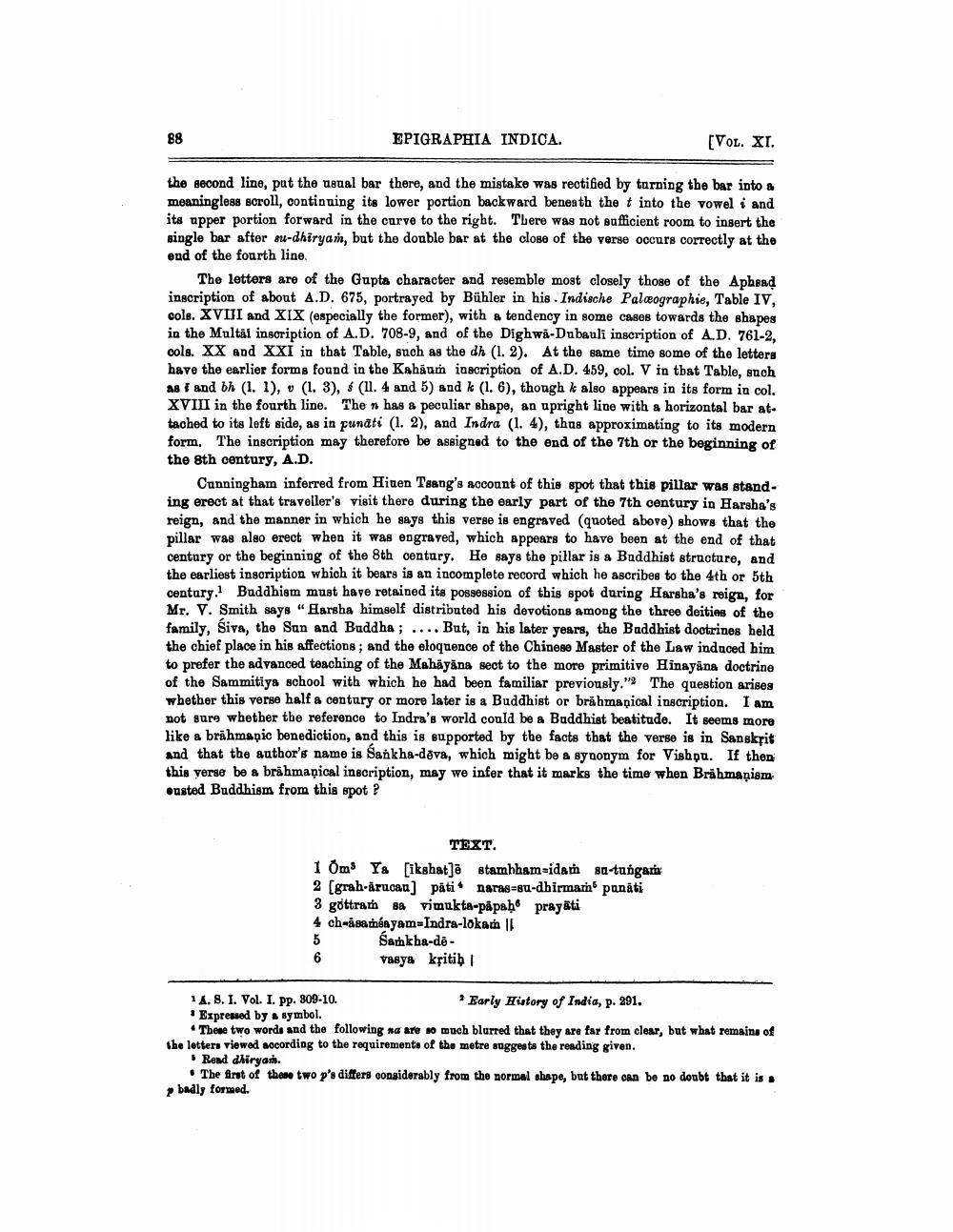________________
EPIGRAPHIA INDICA.
[VOL. XI.
the second line, pat the usual bar there, and the mistake was rectified by turning the bar into a meaninglese scroll, continuing its lower portion backward beneath the t into the vowel i and its apper portion forward in the curve to the right. There was not sufficient room to insert the single bar after su-dhiryan, but the double bar at the close of the verse occurs correctly at the end of the fourth line
The letters are of the Gupta character and resemble most closely those of the Aphead inscription of about A.D. 675, portrayed by Bühler in his . Indische Palæographie, Table IV, cole. XVIII and XIX (especially the former), with a tendency in some cases towards the shapes in the Multät inscription of A.D. 708-9, and of the Dighwa-Dubauli inscription of A.D. 761-2, cols. XX and XXI in that Table, such as the dh (1.2). At the same time some of the letters have the earlier forms found in the Kshäum inscription of A.D. 459, col. V in that Table, such as i and bh (1. 1), - (1. 3), 6 (11. 4 and 5) and k (1. 6), though k also appears in its form in col. XVIII in the fourth line. Then has a peculiar shape, an upright line with a horizontal bar attached to its left side, as in punati (1.2), and Indra (1. 4), thus approximating to its modern form. The inscription may therefore be assigned to the end of the 7th or the beginning of the 8th century, A.D.
Cunningham inferred from Hiuen Teang's account of this spot that this pillar was standing erect at that traveller's visit there during the early part of the 7th century in Harsha's reign, and the manner in which he says this verse is engraved (quoted above) shows that the pillar was also erect when it was engraved, which appears to have been at the end of that century or the beginning of the 8th century. He says the pillar is a Buddhist structure, and the earliest inscription which it bears is an incomplete record which he ascribes to the 4th or 5th century, Buddhism must have retained its possession of this spot during Harsha's reign, for Mr. V. Smith says " Harsha himself distributed his devotions among the three deities of the family, Siva, the Sun and Buddha ; .... But, in his later years, the Buddhist doctrines held the chief place in his affections; and the eloquence of the Chinese Master of the Law induced him to prefer the advanced teaching of the Mahayana sect to the more primitive Hinayana doctrine of the Sammitiys school with which he had been familiar previously." The question arises whether this verse half a century or more later is a Buddhist or brāhmaṇical inscription. I am not sure whether the reference to Indra's world could be a Buddhist beatitude. It seems more like a brähmapic benediction, and this is supported by the facts that the verse is in Sanskrit and that the author's name is Sankha-dova, which might be a synonym for Vishpu. If then this verse be a brähmapical inscription, may we infer that it marks the time when Brühmaņiem oasted Buddhism from this spot?
TEXT. 1 Om Ya [ikshat]ē stambham-idam sa-tungan 2 (grah-årucan) påti Daras=su-dbirmar panati 3 gottram sa vimukta-papaḥ prayati 4 ch-satsayam-Indra-lokar Il
Sakha-deVasya kritih
14. 8. 1. Vol. I. pp. 309-10.
Early History of India, p. 291. * Expressed by a symbol.
• These two words and the following na are so much blurred that they are far from clear, but what remains of the letters viewed according to the requirements of the metre suggests the reading given.
• Rend dhiryan.
• The first of these two p's differs considerably from the normal shape, but there can be no doubt that it is badly formed.




